| |
Transitioning to Frailty for PLWH 2 fold higher, Risk Factors
|
| |
| |
Download the PDF here
2 studies below discussing predictors of transitioning to frailty for PLWH. 2nd study below found 2 fold increased risk vs HIV-i ad predictors included numerous comorbidities, specific comoebidities increased risk, body composition changes - lipostrophy & bely fat accumulation associated with frailty. Depression was found in 1 study associated with frailty but nit in other study where cognitive dysfunction was associated with frailty. Exercise or increasing physical cavity reduced frailty.

Lorenz, David R. PhDa; Mukerji, Shibani S. MDa,b; Misra, Vikas MSca; Uno, Hajime PhDc; Gelman, Benjamin B. MD, PhDd; Moore, David J. PhDe; Singer, Elyse J. MDf; Morgello, Susan MDg; Gabuzda, Dana MDa
Participants were from the NNTC, a longitudinal cohort composed of participants at 4 sites (Galveston, TX, Los Angeles, CA, New York, NY, and San Diego, CA). The NNTC has high rates of morbidity because criteria for entry include a significant neurological or medical condition; age 60 years or older was recently added as qualifying criterion.4
At baseline, the median age was 61 years, 73% were male 98% were on antiretroviral therapy, 29% had ≥3 comorbidities, 27% were robust, and 73% were pre-frail. Cerebrovascular disease, diabetes, and COPD were independent predictors of transition to frailty within 30 months in models adjusted for age, sex, and multimorbidity (≥3 additional comorbidities) [hazard ratios (95% confidence intervals) 2.52 (1.29 to 4.93), 2.31 (1.12 to 4.76), and 1.82 (0.95 to 3.48), respectively]. Furthermore, cerebrovascular disease, diabetes, COPD, or liver disease co-occurring with multimorbidity was associated with substantially increased frailty hazards compared with multimorbidity alone (hazard ratios 4.75-7.46). Cerebrovascular disease was associated with decreased baseline grip strength (P = 0.0001), whereas multimorbidity, diabetes, and COPD were associated with declining grip strength (P < 0.10).
Of 219 eligible participants non-frail at baseline, 27% were robust and 73% were pre-frail (Table 1). The cohort was 73% male 34% White, 35% Black, and 28% Latinx; the median age and duration of HIV infection at baseline were 61 years [interquartile range (IQR), 54-67 years] and 25 years (IQR 19-30 years), respectively. Forty participants (18%) transitioned to frail status within 30 months of follow-up; the median number of assessments was similar between participants who remained non-frail vs. became frail (2.5 and 2.0, respectively; P = 0.191). Participants who became frail were more likely to be pre-frail than robust at baseline (92.5% vs. 68.2%, respectively; P = 0.001); 3 transitioned from robust to frail without intervening assessments categorized as pre-frail. Although mortality within 1 year of endpoint was more prevalent in participants who became frail vs. those who remained non-frail (15.0% vs. 1.1%, respectively; P = 0.001), there were no significant differences in other demographic, HIV-related, and clinical characteristics. Measures of cognitive function in participants who became frail were worse than in those who remained non-frail, including lower median global T-scores [44 (IQR 38-48) vs. 47 (IQR 41-52), respectively; P = 0.007], and fewer classified as neurocognitively normal based on HIV-associated neurocognitive disorder diagnosis (12.5% vs. 33.5%, P = 0.002). Severity of depressive symptoms did not differ by frailty outcomes. As expected, the median grip strength was lower (P < 0.001) and walk time was slower (P = 0.001) at baseline in participants who became frail vs. those who remained non-frail, whereas other FFP components (weight loss, exhaustion, and low physical activity) were not significantly different. Similar associations were observed in unadjusted analyses among 159 participants who were pre-frail at baseline (see Table, Supplemental Digital Content 1, https://links.lww.com/QAI/B726). Among participants with cerebrovascular disease, diabetes, COPD, or class 2 or 3 obesity at baseline (see Table, Supplemental Digital Content 2, https://links.lww.com/QAI/B726), diabetes and BMI >30 kg/m2 were associated with female sex in unadjusted analyses (P = 0.016 and P < 0.001, respectively), whereas other demographic, HIV-related, and clinical characteristics were similar between participants with vs. without these comorbidities.
Among the frailty criteria, weak grip and slow walk speed had the strongest associations with transition to frailty within 30 months in Table 1. Furthermore, longitudinal patterns of individual frailty criteria showed that weak grip was the component most closely associated with transition to frailty (see Supplemental Digital Content 5, https://links.lww.com/QAI/B727 and Fig. 3A), consistent with evidence linking weakening grip to sarcopenia,25 a central feature of physical frailty.
Conclusions:
In older PWH, cerebrovascular disease, diabetes, COPD, or liver disease co-occurring with multimorbidity is associated with substantially increased risk of becoming frail within 30 months. Interventions targeting these comorbidities may ameliorate frailty and age-related functional decline in PWH.
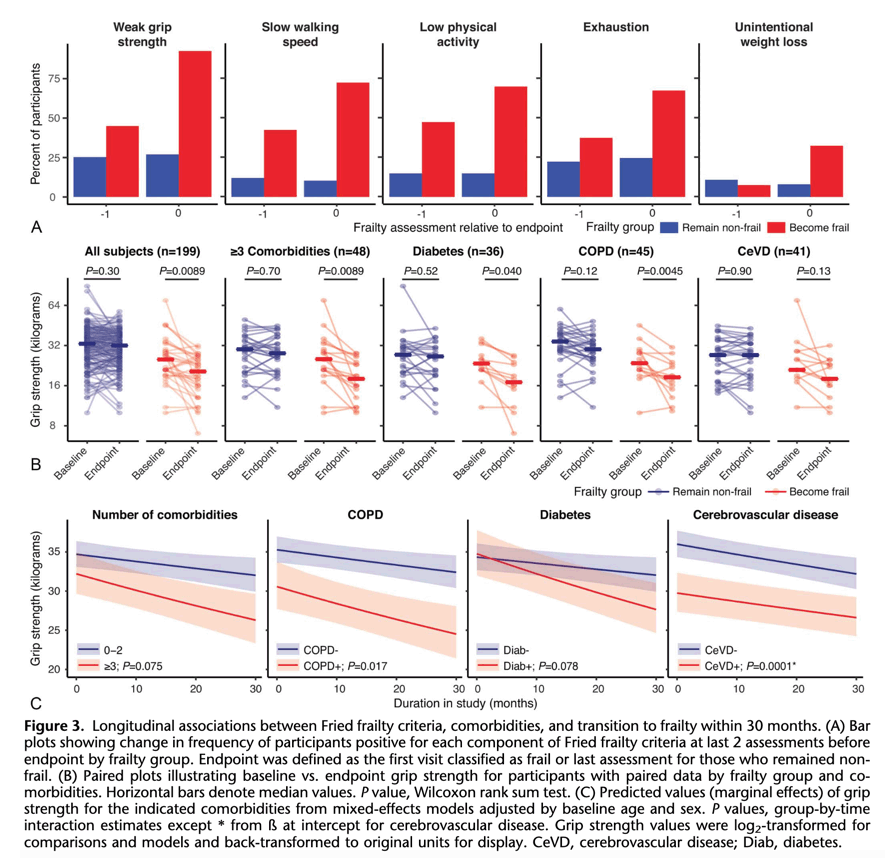
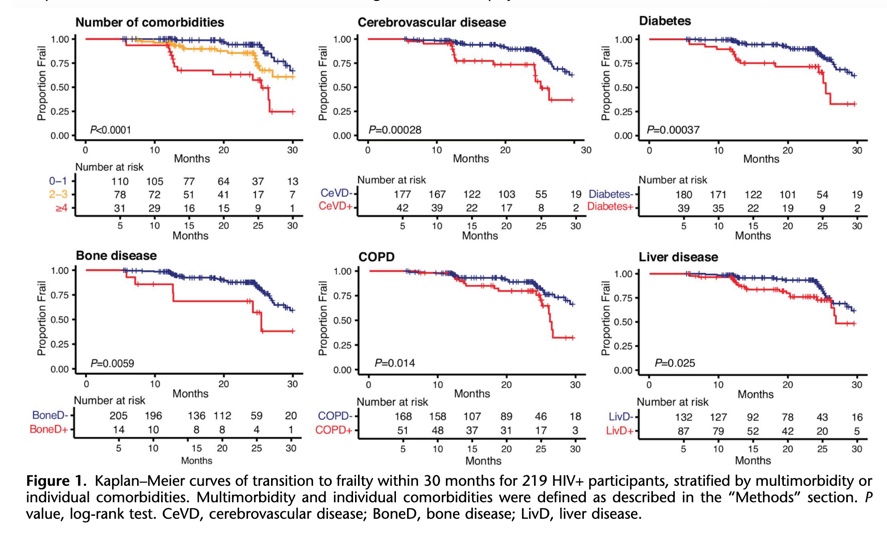
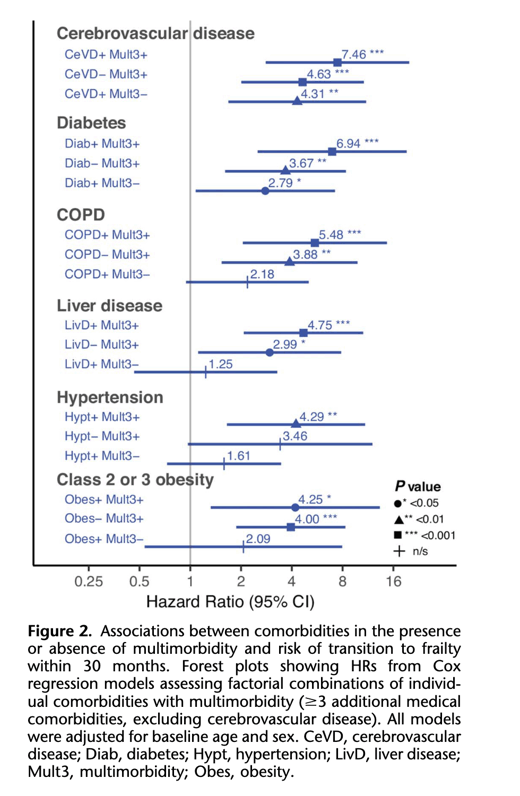
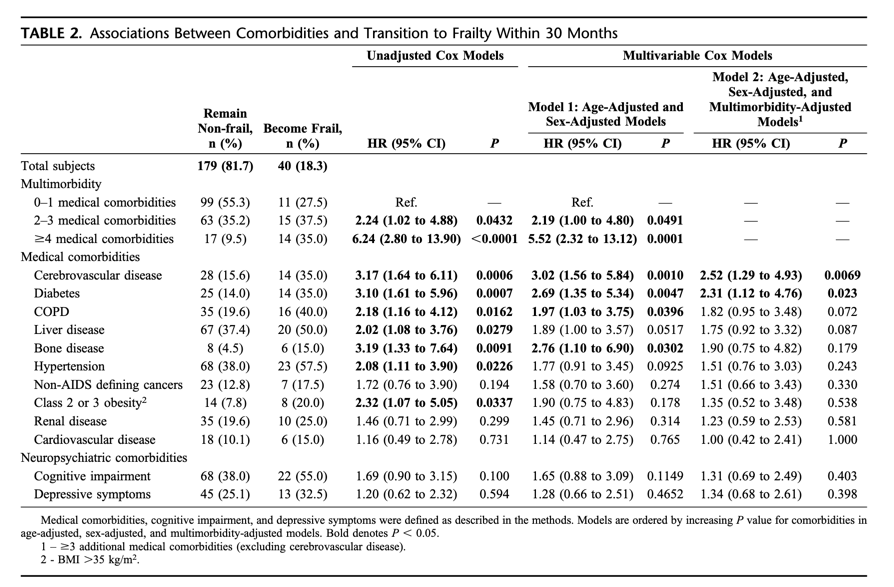

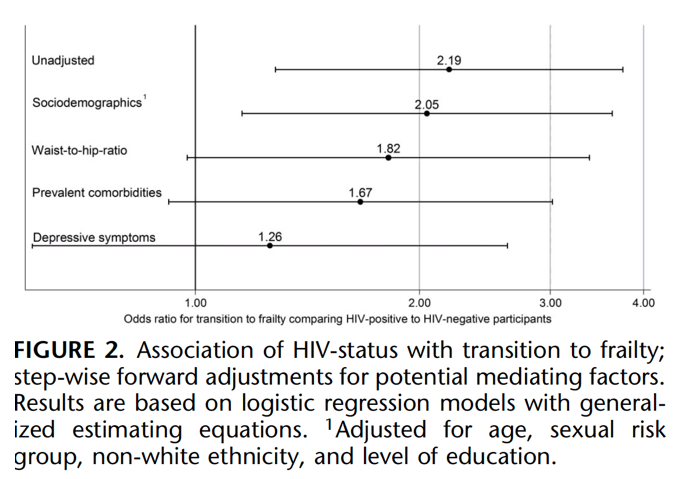
Frequency, Risk Factors, and Mediators of Frailty Transitions During Long-Term Follow-Up Among People With HIV and HIV-Negative AGEhIV Cohort Participants
Verheij, Eveline MDa,b; Wit, Ferdinand W. MD, PhDa,b,c; Verboeket, Sebastiaan O. MDa,b; Schim van der Loeff, Maarten F. MD, PhDd,e; Nellen, Jeannine F. MD, PhDa; Reiss, Peter MD, PhDa,b,c; Kirk, Gregory D. MD, PhDf
Transitioning between frailty states in any direction occurred in 36% of a total of 1833 visit-pairs. The odds of nonfrail participants transitioning toward frailty were significantly higher for PWH, occurring in 35 PWH (7.3%) and 25 (5.2%) HIV-negative nonfrail participants, respectively (odd ratioHIV 2.19, 95% confidence interval 1.28 to 3.75). The increased risk among PWH was attenuated when sequentially adjusting for waist-hip ratio, number of pre-existent comorbidities, and the presence of depressive symptoms.
Transitions did not occur in 1174 of the total 1833 visit-pairs (64%): 682 visit-pairs (37% of total) remained robust, 449 (25%) visit-pairs remained prefrail, and 43 (2%) visit-pairs remained frail. In the remaining 659 (36%) visit-pairs in which transitions did occur, 305 (46.0%) were in the direction of frailty (from robust/prefrail to prefrail/frail) and 354 (54.0%) in the direction of robustness (from prefrail/frail to robust/prefrail). For both PWH and HIV-negative participants (Fig. 1), direct transitions in either direction between the robust and frail states were very infrequent (<0.8% for any). In contrast, transitions occurred most frequently between the robust and prefrail states (29% of all transitions). During study follow-up, 35 (3.8%) PWH and 25 (2.7%) HIV-negative participants transitioned to frailty, respectively. For those transitioning to frailty, most were prefrail at the previous study-visit (Fig. 1). Of all participants who were classified as frail during at least one study visit, most of them did so during only a single study visit (78.7%) with most transitioning back to the prefrail state. Thirty-eight deaths were observed overall, with a greater proportion among PWH compared with HIV-negatives (5.2% versus 1.3%).
CONCLUSIONS
As our study shows, frailty is one end of the spectrum of what is a highly transitional phenotype. Multiple distinct factors may contribute to frailty transitions, with many of those factors-such as higher waist-to-hip-ratio, a higher number of prevalent comorbidities and having depressive symptoms-being potentially preventable and reversible, and thus deserving attention as part of routine HIV care. A recent systematic review showed that increasing the level of physical activity significantly reduced frailty.27 A growing body of evidence suggests that PWH experience frailty to a greater degree than the general population, and that frailty is associated with adverse outcomes in this population. We advocate that interventions to reduce frailty development should be investigated among our aging HIV patients. Whether increasing the level of physical activity may also prevent transition to frailty and ameliorate its downstream adverse health outcomes, should be investigated among PWH.
In an earlier analysis from our AGEhIV cohort, we reported a significantly higher prevalence of frailty among PWH.4 We now extend these findings by demonstrating that PWH also are more likely to become frail during long-term follow-up.
Higher age, higher number of comorbidities, and having depressive symptoms, were each independently associated with transition to frailty> in the multivariable models (see Table 3, Supplemental Digital Content, https://links.lww.com/QAI/B551)
The presence of a higher number of prevalent comorbidities was also independently associated with an increased likelihood of transitioning to frailty.10
frailty did also develop in some individuals without any overt comorbidity (n= 19, ie, 32% of those who transitioned to frailty; indifferent by HIV-status, P = 0.143), supporting the concept of frailty as an overall decline in multiple organ systems, which is not necessarily simply a direct consequence of the number of comorbidities.
As was the case for the number of prevalent comorbidities, having depressive symptoms both attenuated the association between HIV-positive status and transitioning to frailty, and was itself independently associated with transition to frailty, confirming results from the WIHS17 and MACS HIV cohort studies.15 These results underline the need for proper attention to symptoms of depression in the care of PWH, not only to improve mental health but potentially also to help ensure current and future physical health.
Apart from the known association between abdominal obesity and frailty in the general population,11-13 highly treatment-experienced PWH may develop persistent lipoatrophy and sarcopenia as a result of past exposure to thymidine analogues and/or severe HIV disease, features which may also contribute to the development of frailty. The increased waist-to-hip-ratio among PWH that we observed is the result of both an increased waist circumference and a smaller hip circumference compared with the HIV-negative participants, consistent with these well-characterized body-composition changes among PWH.14 Notably, waist-hip ratio was not significantly associated with transitioning to frailty, but did seem to mediate the HIV effect. In further support of the differential body-composition hypothesis among PWH, we demonstrated that smaller hip-circumference, as possible proxy for lipoatrophy, was significantly associated with frailty only among PWH but not among our HIV-negative participants.
In unadjusted analyses, HIV-positive status was associated with a >2-fold higher odds [odd ratio (ORHIV) 2.19, 95% confidence interval (CI): 1.28 to 3.75, P = 0.004] of transitioning to frailty (Fig. 2). In multivariable models, this association was increasingly attenuated after stepwise adjustment for sociodemographic factors (ORHIV 2.05, 95% CI: 1.16 to 3.63, P = 0.014), WHR (ORHIV 1.82, 95% CI: 0.97 to 3.39, P = 0.06), and no longer significant after additional adjustment for number of pre-existing comorbidities (ORHIV 1.57, 95% CI: 0.83 to 2.97, P = 0.16) and depressive symptoms (OR 1.27, 95% CI: 0.65 to 2.50; P = 0.48) (Fig. 2, see Table 2, Supplemental Digital Content, https://links.lww.com/QAI/B551).
No interactions were observed between variables in the final model; however, when re-introducing the different components of the waist-to-hip-ratio separately, a significant interaction between hip-circumference and HIV-status was observed (P-interaction = 0.01). For PWH, the OR for transitioning to frailty for each centimeter smaller hip-circumference was significant (OR 1.08, 95% CI: 1.02 to 1.14, P = 0.006), but not for HIV-negative participants (OR 0.96, 95% CI: 0.90 to 1.03, P = 0.275).
hs-CRP, D-dimer, and I-FABP were associated with transition to frailty in unadjusted models. After adjusting for sociodemographic variables, D-dimer and I-FABP were no longer associated with transitioning to frailty. High-sensitivity CRP remained associated with transitioning to frailty after adjusting for socio-demographics and waist-to-hip-ratio, but lost significance after adjusting for the prevalent number of comorbidities.
In unadjusted analysis, older age, a higher number of prevalent comorbidities, and higher level of depression were associated with lower odds of transitioning back from frailty (see Table 4, Supplemental Digital Content, https://links.lww.com/QAI/B551). In multivariable analysis, having a higher number of prevalent comorbidities resulted in a lower OR to transition to robustness (OR 0.22, 95% CI: 0.06 to 0.81, P = 0.023) (see Table 4, Supplemental Digital Content, https://links.lww.com/QAI/B551, model C).
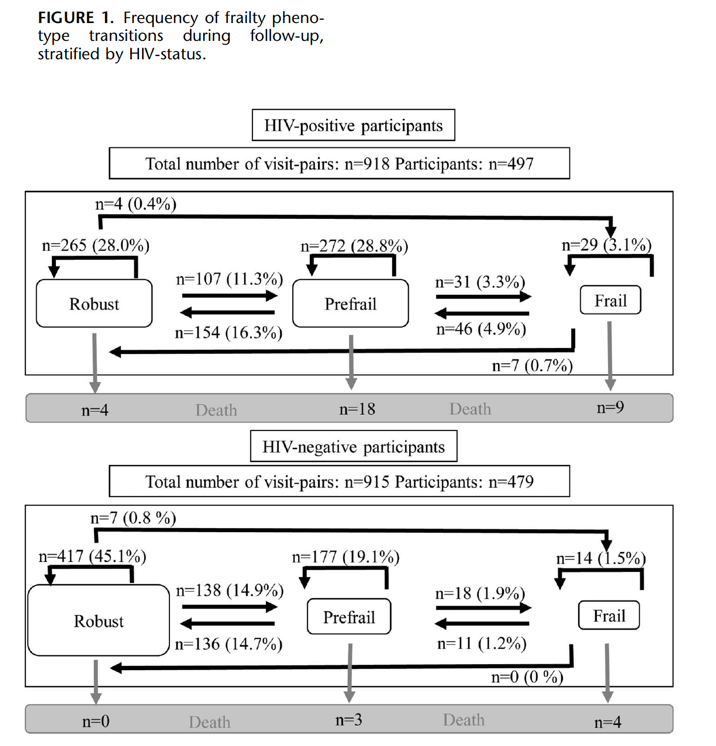
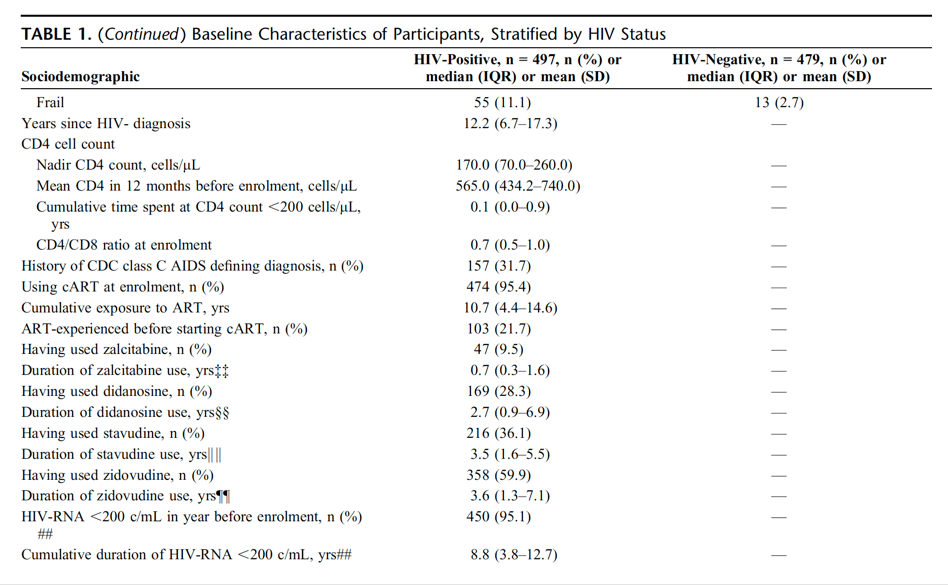
|
|
| |
| |
|
|
|